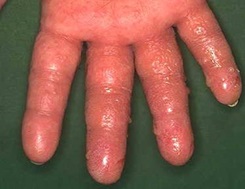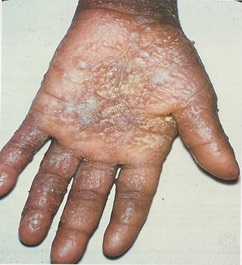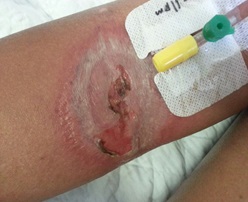Allergic dermatitis is a form of exogenous dermatitis or eczema. Allergic dermatitis is divided to irritant contact dermatitis and allergic contact dermatitis. As in allergic contact dermatitis, irritant dermatitis is also an itchy skin condition which occurs when the skin is in contact with irritants. The eczema is often well demarcated with a glazed surface with associated redness, itching, swelling and blisters over the affected area. This causes severe itchiness and makes the patient feel miserable. Examples of common irritants are water, soaps, detergents, solvents, acids and alkalis. Irritant contact dermatitis may affect anyone, providing they have had enough exposure to the irritant, especially those with defective barrier function e.g. atopic eczema individuals. Irritant contact dermatitis is much more common than allergic contact dermatitis. 80% of cases of occupational hand dermatitis are due to irritants, most often affecting cleaners, hairdressers and food handlers. Irritants damage the skin by removing oils and moisture from its outer layer, allowing the irritants to penetrate more deeply and cause further damage by triggering inflammation
The severity of the dermatitis depends on many factors including:
- Amount and strength of the irritant
- Length and frequency of exposure
- Underlying eczema or existing atopic tendency
- Environmental factors (eg. high or low temperature or humidity)
Signs and Symptoms
These include red inflamed itchy skin or red bumps, blisters, crusting, cracking and weepiness. Clinically, the eczema occurs at the site of contact with the allergen but in severe cases secondary spread may occur and eventually may cause generalization involving various part of the body even at areas of no contact. Eczema is usually confined to the area of contact with the irritant. If the eczema is prolonged it may spread to unaffected areas but it is less likely.
Strong irritant such as a strong acid or alkali substance may cause pain, swelling and blistering within a short time. Contact with mild irritants such as water and soap or detergent over a period of weeks may cause dryness, itching and cracking of the skin leading to fissuring and crusting
Below are some examples of irritant contact dermatitis:
 |
Irritant contact dermatitis presenting with itchy vesicles, erythematous papules and weepy lesions |
 |
A police officer cleaning gun with alkaline solvent for 30 minutes. Within 45 minutes developed burning of skin on his palm and blistering |
 |
A patient who had his skin cleaned with iodine prior to branula insertion. Developed blistering and erosion within half hour of procedure |
Complications
- Due to cracking of the skin, bacteria or fungus may cause infection of the skin.
- Chronic scratching may become habitual resulting in thick, leathery and hyperpigmented skin. This is known as neurodermatitis or lichen simplex chronicus
Investigations
- To diagnose contact dermatitis sometimes may not require any specific test. A good history is essential which includes both occupational and domestic exposure to allergens. Irritant contact dermatitis is suspected when there is obvious contact with an allergen resulting in eczematous reaction .
- Patch test is not advisable as it will cause severe burns to the patient.
- Patch test is used to confirm allergic contact dermatitis and identify the allergen but they do not exclude irritant contact dermatitis as the two may coexist.
Treatment
- Avoid the allergen. For the treatment of acute eczema, soak with saline or potassium permanganate and then apply the prescribed topical corticosteroids.
- In chronic cases, treatment usually consists of moisturisers and topical corticosteroids.
- In severe cases, oral prednisolone may be required.
- If bacterial infection is suspected, a course of systemic antibiotics may also be prescribed.
Prevention
- There is a need to understand your environment to avoid exposure to the allergen
- Use protective gloves when carrying out household tasks
- Use moisturizer frequently to improve the barrier function of the skin
References
- Usatine RP, Riojas M. Diagnosis and management of contact dermatitis. Am Fam Physician. 2010; 82:249-255.
- Gober MD, DeCapite TJ, Gaspari AA. Contact dermatitis. In: Adkinson NF Jr, ed. Middleton’s Allergy: Principles and Practice. 7th ed. Philadelphia, Pa: Mosby Elsevier; 2008:chap 63.
- Habif TP. Contact dermatitis and patch testing. In: Habif TP, ed. Clinical Dermatology. 5th ed. Philadelphia, Pa: Mosby Elsevier; 2009:chap 4.
- Weston WL, et al. Overview of dermatitis. http://www.uptodate.com/home/index.html. Accessed April 26, 2011.
- Seyfarth F, et al. Teaching interventions in contact dermatitis. Dermatitis. 2011;22:8.
| Last Reviewed | : | 23 August 2019 |
| Writer | : | Dr. Dawn Angelia Ambrose |
| Accreditor | : | Datin Dr. Asmah bt. Johar |
| Reviewer | : | Dr. Nazatul Shima bt. Abd Rahim |







